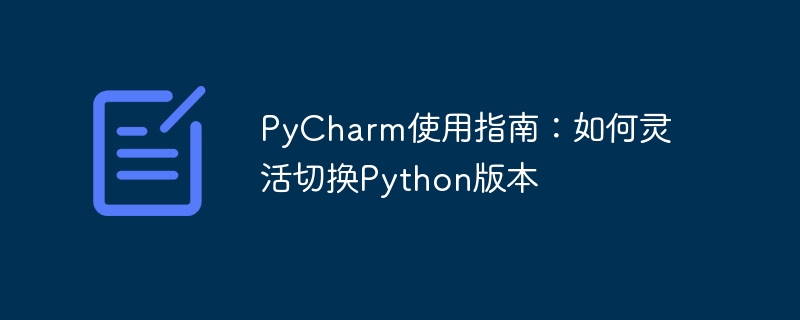

PyCharm User Guide: How to flexibly switch Python versions
Introduction: Python is a very popular programming language, and new versions are constantly being released to provide developers with more information. Versatile and optimized. However, due to limitations of project requirements and dependencies, sometimes we need to flexibly switch between different Python versions. This article will introduce how to use PyCharm to easily switch Python versions and provide specific code examples.
1. Install PyCharm and multiple Python versions
First, make sure that PyCharm and multiple Python versions are installed. PyCharm is a powerful Python integrated development environment that supports code editing, debugging and version control during the development process.
Before installing PyCharm, we need to install multiple Python versions on the system. You can find various versions of Python on the official Python website (https://www.python.org/downloads/) and choose the version that matches your project needs. Download and install the required Python version.
2. Configure PyCharm
3. Switch Python version
After the configuration is completed, you can follow the following steps to switch the Python version:
4. Code Example
The following is a simple code example that demonstrates how to switch the Python version in PyCharm:
import sys
print("当前使用的Python版本是:" + sys.version)
# 切换Python版本为3.7
sys.version_info = (3, 7)
print("切换到Python 3.7版本后,Python版本为:" + sys.version)
# 切换Python版本为3.8
sys.version_info = (3, 8)
print("切换到Python 3.8版本后,Python版本为:" + sys.version)When running the above code, you You can observe changes in the output results by switching Python versions.
5. Summary
Through the introduction of this article, you have learned how to use PyCharm to flexibly switch Python versions. PyCharm's powerful features allow developers to easily switch between different Python versions to meet project needs. During the actual development process, rationally selecting and switching Python versions based on the project's requirements and dependencies will help improve development efficiency and code quality.
I hope this article will help you use PyCharm for Python development!
The above is the detailed content of Flexible switching of Python versions: A complete guide to using PyCharm. For more information, please follow other related articles on the PHP Chinese website!
 How to change pycharm to Chinese
How to change pycharm to Chinese
 pycharm installation tutorial
pycharm installation tutorial
 How to solve the problem that pycharm cannot find the module
How to solve the problem that pycharm cannot find the module
 How to install pycharm
How to install pycharm
 The difference between python and pycharm
The difference between python and pycharm
 How to configure the pycharm environment
How to configure the pycharm environment
 How to install the pycharm interpreter
How to install the pycharm interpreter
 What does pycharm mean when running in parallel?
What does pycharm mean when running in parallel?




